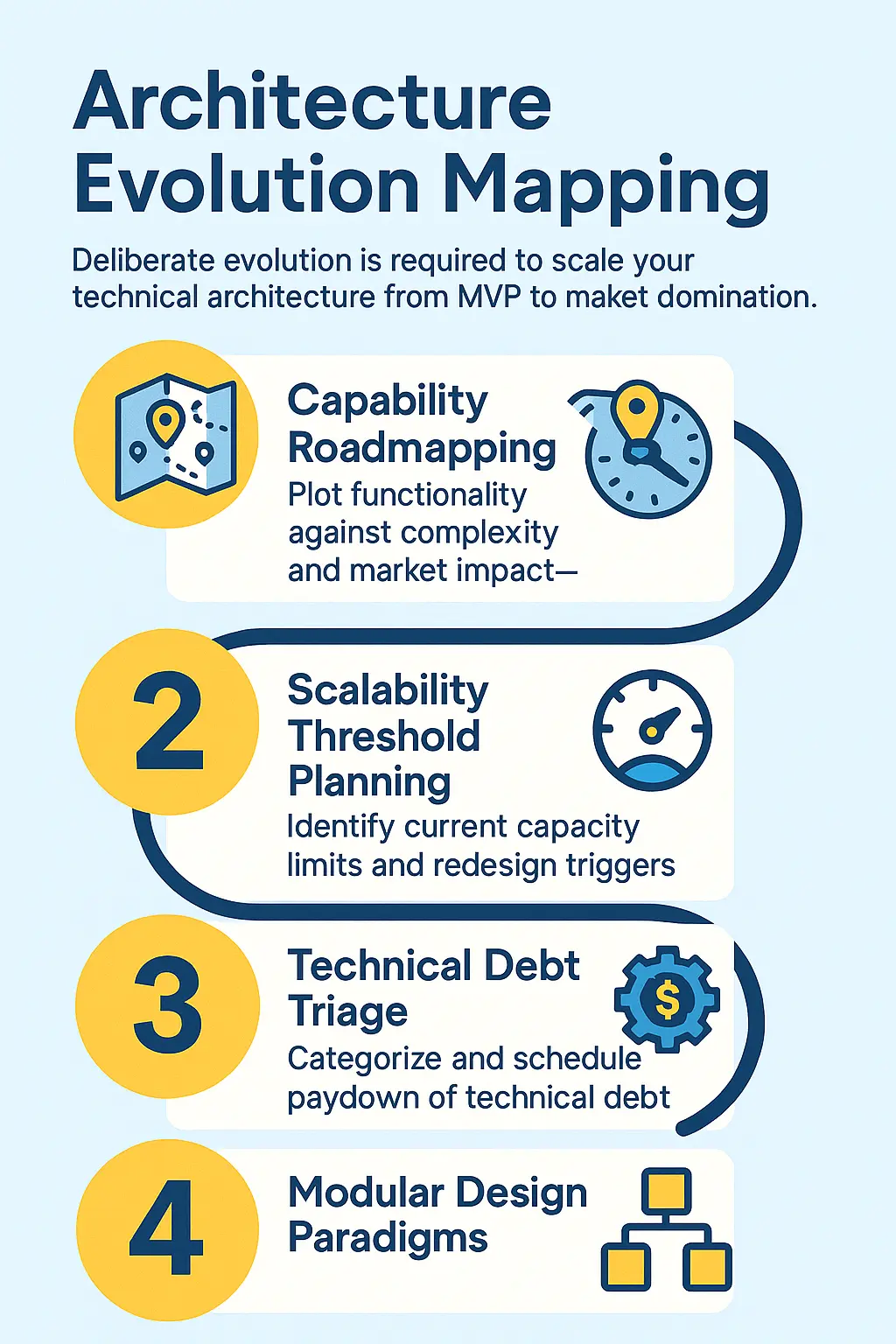
From MVP to Market Domination
Master the technical and strategic architecture decisions that separate scaling SaaS ventures from those that collapse under their own weight
From MVP to Market Domination
The anatomy of SaaS failure reveals a sobering pattern: 70% of ventures that survive product-market fit still stumble when scaling their technical architecture. I've watched promising startups implode not from lack of market demand, but from the crushing weight of architectural decisions made in the MVP phase. Their cautionary tales share a common thread—foundations built for validation, not acceleration.
Today, I'm dismantling the false dichotomy between "moving fast" and "building right." Having guided dozens of SaaS platforms through the treacherous terrain between early validation and hypergrowth, I've mapped the architectural inflection points that determine whether your codebase becomes your competitive advantage or your growth ceiling.
Architecture Evolution Mapping
The journey from MVP to market domination requires deliberate evolution across your technical landscape, not merely adding features to a static foundation.
Strategic Architecture Progression:
- Capability Roadmapping: Develop a capability evolution matrix that plots critical functionality against technical complexity and market impact. This creates clear swim lanes for architectural investment that aligns with customer value.
- Scalability Threshold Planning: Identify the breaking points in your current architecture before you reach them. Document system components with their current capacity limits and create pre-emptive redesign triggers tied to specific growth metrics.
- Technical Debt Triage: Categorize accumulated technical debt into "strategic" (deliberate trade-offs that accelerated time-to-market) versus "accidental" (suboptimal implementations due to knowledge gaps). Set explicit paydown schedules for each category.
Consider Stripe's methodical evolution from a simple payments API to a comprehensive financial infrastructure platform. Their architecture evolved not through random feature accumulation but through deliberate capability expansion that maintained core simplicity while extending reach.
Modular Design Paradigms
Scaling architecture requires breaking monolithic systems into components that can evolve independently without cascading disruption.
Component Isolation Strategy:
- Domain-Driven Boundaries: Segment your architecture along natural business domain lines rather than technical function. This creates context boundaries that enable teams to innovate independently.
- Interface Stability Contracts: Establish explicit versioning and deprecation policies for both internal and external APIs. This preserves compatibility while enabling evolution under the surface.
- Stateless Service Migration: Gradually migrate stateful components to stateless services that scale horizontally, beginning with high-throughput, low-complexity functions.
Airtable's growth from collaboration tool to platform ecosystem exemplifies this approach. Their architecture evolved from a single-purpose application to a modular system where independent teams could extend platform capabilities without destabilizing core functions.
Scalability Engineering Methodology
Architecting for scale requires identifying performance bottlenecks before they become customer-facing issues.
Proactive Scaling Protocol:
- Load Pattern Modeling: Analyze current usage patterns to create synthetic load models that simulate 10x, 100x, and 1000x traffic scenarios. Test these models against your architecture to identify breaking points before they occur in production.
- Performance Envelope Mapping: Document the performance boundaries of each system component under various load conditions. This creates an architectural "stress map" revealing which components need redesign as you scale.
- Resource Elasticity Design: Implement auto-scaling mechanisms that respond to demand fluctuations without human intervention, creating breathing room for growth spikes without overprovisioning.
Slack's evolution from startup messaging app to enterprise platform required this forward-looking approach. Their architecture anticipated scaling challenges by identifying chat synchronization as a critical bottleneck and redesigning this core function before hitting scale limitations.
Integration Strategy Framework
As your product expands, your integration capabilities become a crucial competitive differentiator.
Ecosystem Architecture Planning:
- API-First Development: Restructure development workflows to prioritize API design before implementation, ensuring every feature is accessible programmatically from inception.
- Extensibility Layer Design: Create dedicated extension points within your architecture that expose core capabilities while isolating third-party code from your critical systems.
- Partner Pipeline Development: Establish technical frameworks for partner integration that balance security constraints with development velocity.
Twilio's transformation from communications API to comprehensive engagement platform illustrates this principle. Their architecture evolved to support thousands of integration partners without compromising core stability, creating a virtuous cycle where each integration increased platform value.
Technical Evolution Roadmap
Having guided dozens of SaaS ventures through growth-stage architectural evolution, I've distilled the process into a structured 90-day transformation framework:
Month 1: Architecture Assessment
- Weeks 1-2: Document current architecture and identify scaling constraints
- Week 3: Create load models and performance testing framework
- Week 4: Prioritize architectural improvements against business impact
Month 2: Evolution Planning
- Weeks 5-6: Design modular architecture with clear domain boundaries
- Weeks 7-8: Create migration strategy with minimal disruption
Month 3: Implementation Kickoff
- Weeks 9-10: Implement highest-priority architectural improvements
- Weeks 11-12: Establish monitoring and metrics for architectural health
This progressive approach prevents the "big rewrite" temptation while systematically evolving your architecture to support growth.

The Implementation Imperative
The stakes of architectural evolution extend far beyond technical elegance. Well-executed architectural transitions deliver:
- Velocity Preservation - Maintain development speed even as your codebase and team expand
- Reliability Engineering - Build systems that degrade gracefully rather than fail catastrophically
- Scale Economics - Create infrastructure that scales sublinearly with customer growth
- Innovation Enablement - Build foundations flexible enough to support unexpected product directions
Architecture isn't merely technical plumbing—it's the skeletal structure that determines how far and fast your product can evolve.
Strategic Next Steps
As you embark on your architectural evolution journey:
- Business-First Architecture - Align technical decisions with business outcomes, not technical elegance
- Evolutionary vs. Revolutionary - Prefer incremental improvements over high-risk rewrites
- Component Thinking - Design systems as collections of loosely-coupled services
- Observability Integration - Build comprehensive instrumentation into your architecture from day one
Tomorrow, we'll explore how to build customer acquisition engines that scale alongside your architectural foundations, creating compound growth that transforms market traction into market dominance.
Remember: In SaaS, architectural decisions aren't just technical choices—they're strategic bets that determine whether your product becomes a vulnerable single-point application or an expansive, defensible platform ecosystem.
Related Articles

Making Your SaaS Succeed: The Validation Blueprint
Discover the systematic validation framework used by 7-figure SaaS founders to ensure market fit before writing a line of code

The Customer Acquisition Playbook for Early-Stage SaaS
The low-cost, high-impact acquisition strategies that transformed bootstrapped startups into billion-dollar platforms